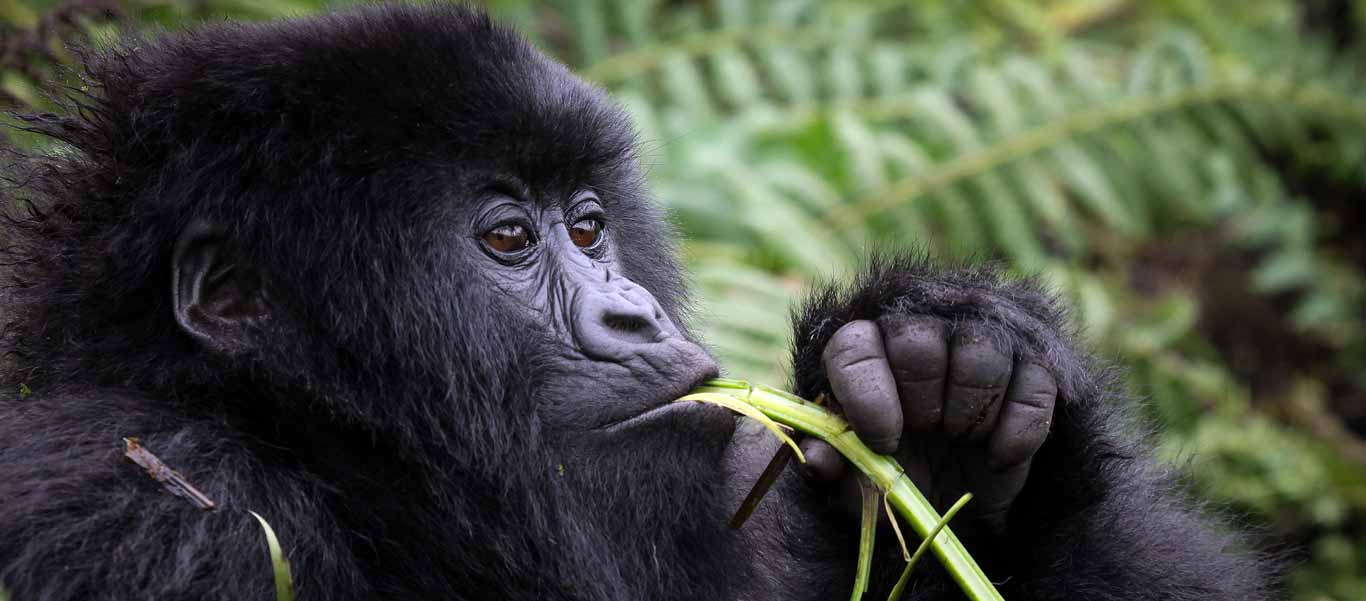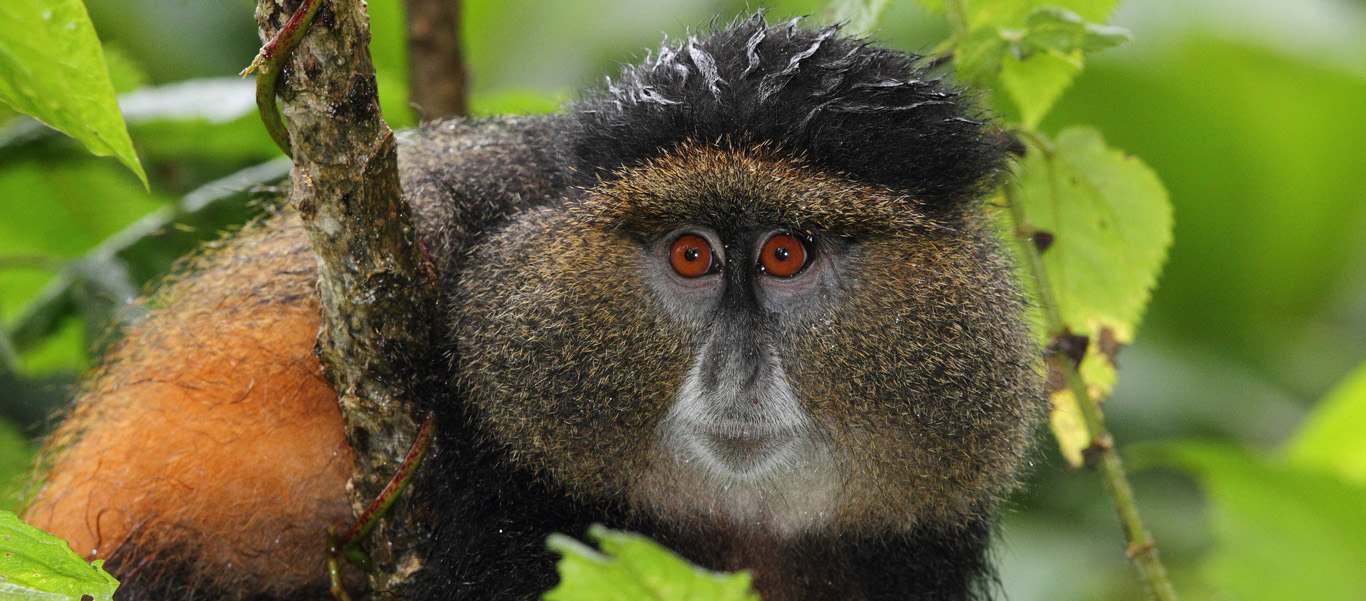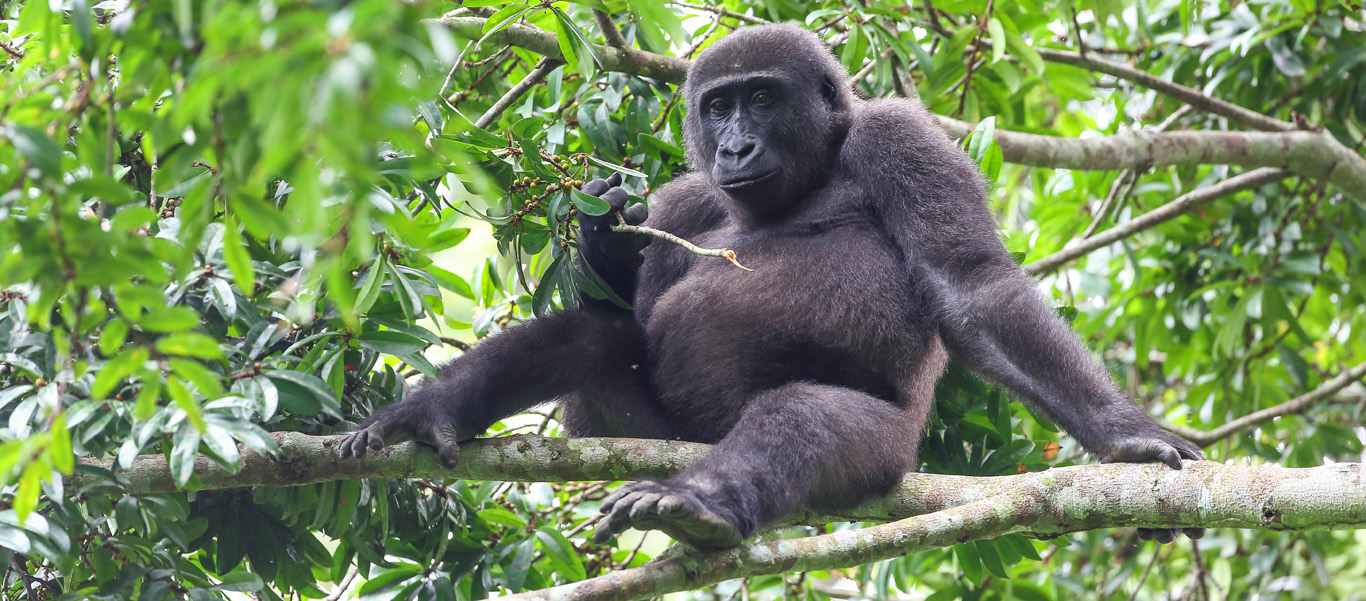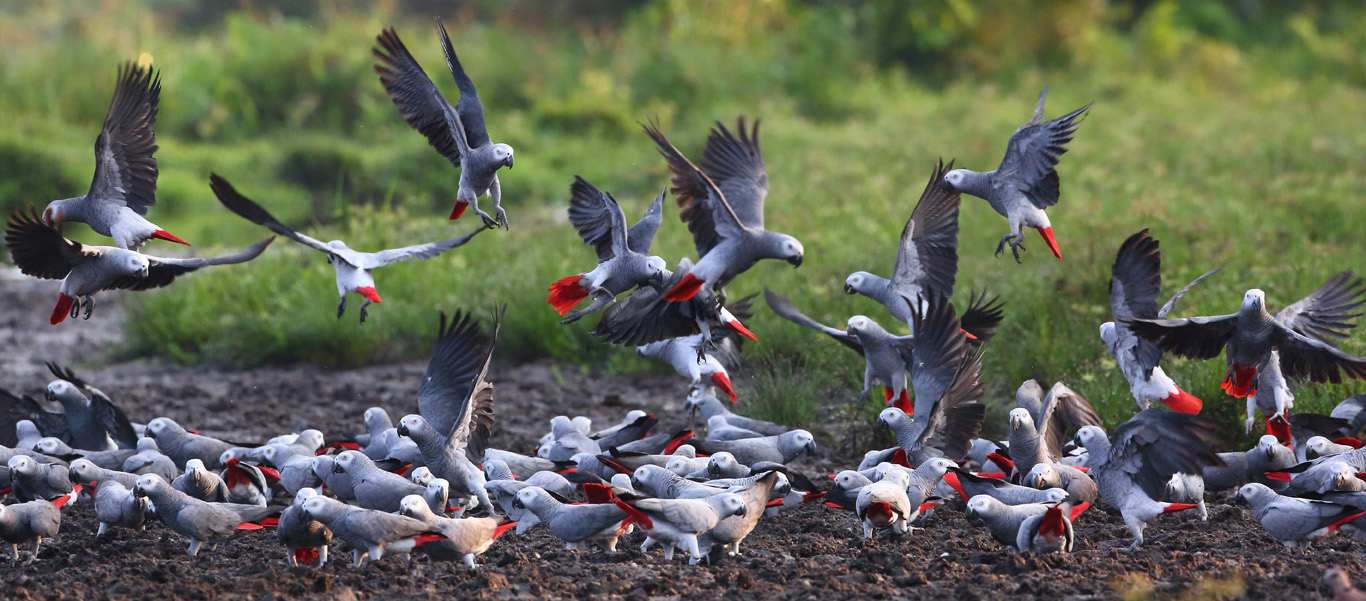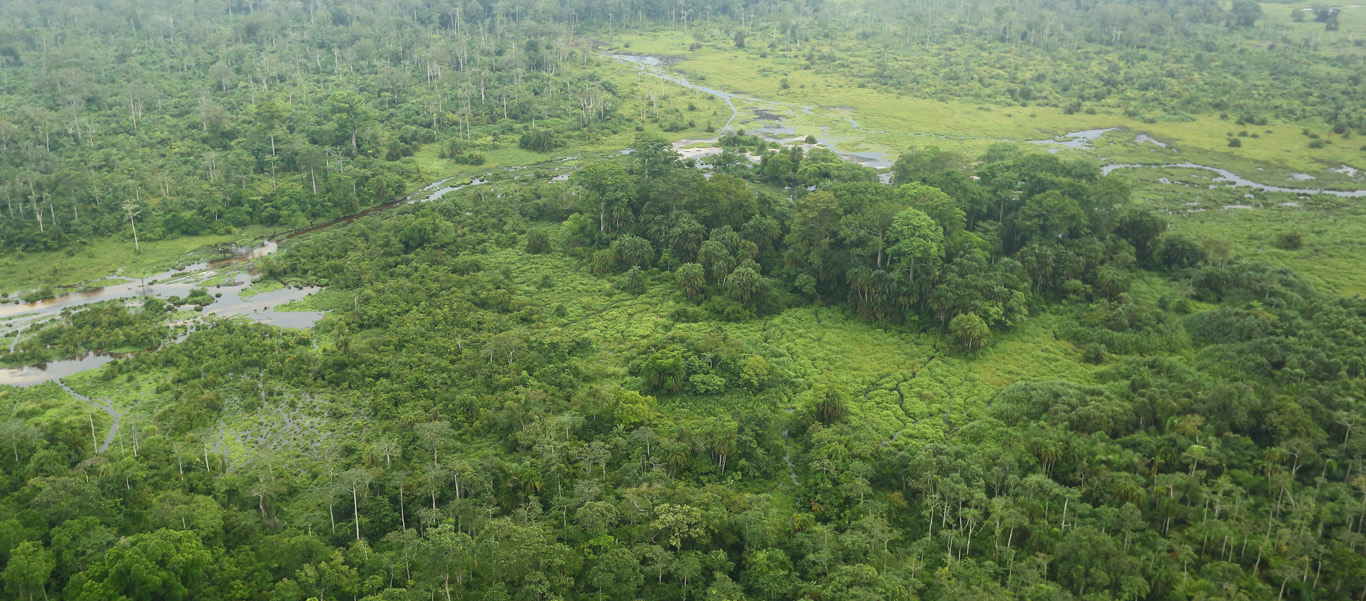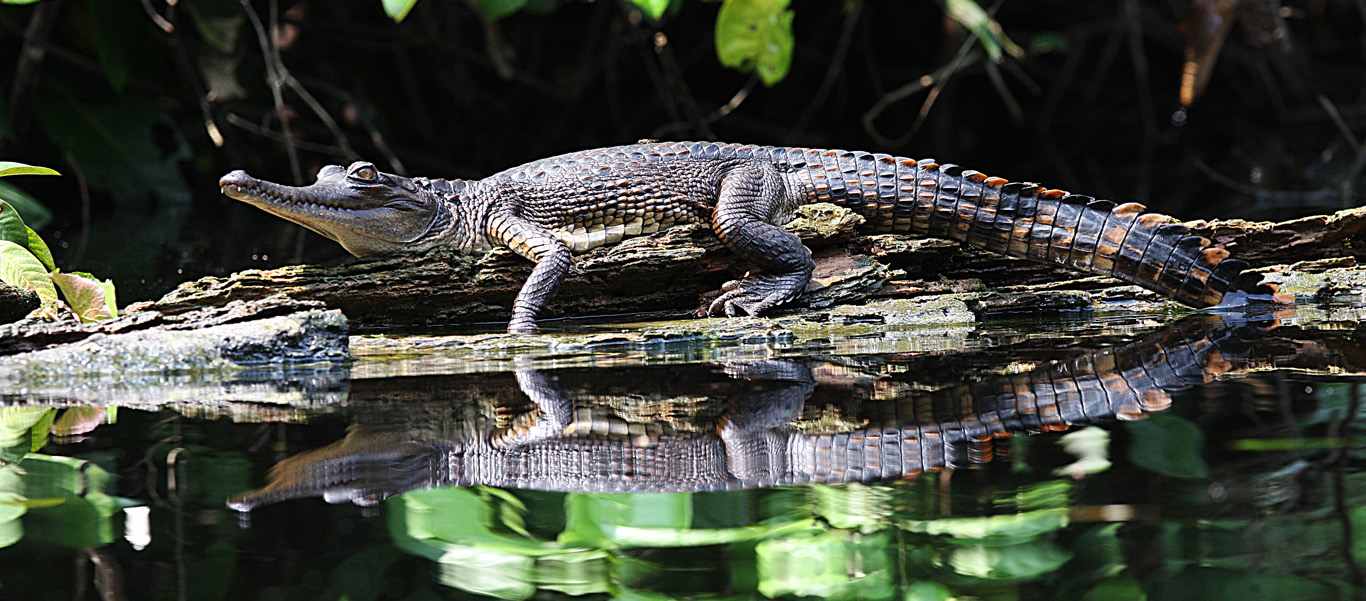Congo & Rwanda
Congo & Rwanda Gorilla Safaris
If you’re a wildlife enthusiast, you’ve almost certainly had this dream—you’re perched, motionless, beside a tangle of Galium vines, and you’re watching, mouth agape, as a family of wild gorillas frolics just feet away. You gaze at the unthinkably giant Silverback, before he ambles over to wrestle with some youngsters, and marvel at our behavioral similarities. Apex Expeditions is making this dream a reality, seeing not one, but both species of gorillas on one trip. Visit two of the most pristine regions of central Africa—the Congo Basin, home to the world’s second-largest tropical rainforest, and greatest density of Western Lowland Gorillas; and the towering mountains of Rwanda, to observe some of the last remaining wild Mountain Gorillas. View many other rare and fascinating animals en route, including Forest Elephants, Forest Buffalo, Guereza Colobus and Golden Monkeys, and a plethora of smaller Congolese fauna. Join us on this wide-reaching dream trip into the home turf of Africa’s great apes.
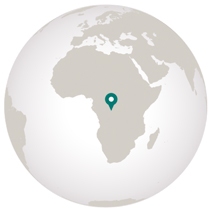
Destinations
- Travel by Air
- Travel by Road
- Travel by Boat
- Travel by Bullet Train
- Travel by Rail
- Travel by Dog Sled
-
Wednesday, July 10: Arrive Brazzaville, Republic of Congo
Arrive in Brazzaville, capital of the Republic of Congo, the jumping-off point for our wildlife adventure. Brazzaville’s past as a French colony will quickly be evident in its cathedrals, museums, and boulevards. The Republic of Congo (not to be confused with its hulking, and less politically stable, neighbor south of the river, the Democratic Republic of Congo) is one of the most urbanized nations in Africa. Brazzaville sits on the north bank of the Congo River, opposite Kinshasa. This is the only place in the world where two national capital cities are on opposite sides of a river, within sight of each other. Aside from a small strip of coastline, Congo is covered by virtually untouched tropical rainforest, home to the world’s largest population of Western Lowland Gorillas and wild Chimpanzees. Welcome dinner and overnight at the Radisson Blu M’Bamou Palace Hotel.
-
Thursday, July 11: Brazzaville / Odzala National Park: Ngaga Camp
After breakfast, a short flight delivers you to Odzala-Kokoua National Park, in the northwest of the Congo. At 5,000 square miles, Odzala-Kokoua is a ‘frontier forest’, crossing national boundaries and harboring some of the last extensive blocks of Congolese forest ecosystems. It is one of the most important strongholds for Western Lowland Gorilla conservation remaining in Central Africa. With 60 inches of rain annually, the region houses a rich diversity of swampy and terra firma forests, savannah and rivers, providing ideal habitat for more than 400 bird species, 114 mammal species and over 4,400 varieties of plants. Upon arrival at the airstrip, drive through the park to Ngaga Camp, in the southwest of Odzala-Kokoua National Park. Located in the heart of the rainforest, Ngaga Camp’s comfortable, beehive-shaped huts, modeled on the design of local dwellings, are situated in a sea of Marantaceae, often-impenetrable giant herbs in the Arrowroot family. This is the habitat that supports Africa’s densest population of Western Lowland Gorillas, which you will spend the next two days tracking. If time permits this afternoon, take a forest walk by the Ngaga stream below camp. Before dinner, there will be a briefing on Western Lowland Gorillas, and what to expect when tracking the two habituated Ngaga groups. Dinner and overnight at Ngaga Camp.
-
Friday and Saturday, July 12 & 13: Ngaga Camp
Wake up before dawn each morning. After breakfast, join your expert tracker-guide on foot, starting the gorilla tracking where the selected family group slept the night before. Though their home range sizes are relatively small, they can move quickly through the thick Marantaceae, and you may cover anywhere from two to five miles locating them. The dry season, from June to August, is the best time of year to spot and photograph these magnificent apes, as they spend larger amounts of time up in the fruiting trees, more exposed than when they’re on the ground. Once the gorillas are found, settle in and note the sheer size and strength of the Silverback; watch the youngsters play as their mothers forage for food.
The afternoon can be spent on a forest walk, with luck spotting de Brazza’s and Mustached Monkeys. Odzala is also home to the largest concentration of Chimpanzees in central Africa, which, while often heard on these forest walks, are rarely seen by visitors. Birders may catch a glimpse of the outlandish Great Blue Turaco or one of the Congolese ‘specials,’ such as the shy Plumed Guineafowl and Bare-cheeked Trogon. As the sounds of the Congo forest denizens rise after dark, be sure to take advantage of a night walk in search of Southern Needle-clawed and tiny Demidoff’s Dwarf Galagos, also known as bushbabies. Also keep watch for the vociferous Western Tree Hyrax, the gliding Lord Derby’s Anomalure, or perhaps even Milne-Edwards’ Potto, a bizarre slow-moving primate known locally as the “softly-softly”.
-
Sunday, July 14: Odzala National Park: Lango Camp
Following breakfast, load up the vehicles for a game drive to Lango Camp, located on the edge of the forest by the Lekoli and Mambili Rivers. Your route passes through a mosaic of closed-canopy forest and tall savannah, where clouds of multi-hued butterflies rise off the track, raucous hornbills are conspicuous overhead, and small herds of Forest Buffalo are commonly encountered at roadside mud wallows. Dinner and overnight at Lango Camp.
-
Monday & Tuesday, July 15 & 16: Lango Camp
One of the unique aspects of Odzala is its numerous clearings, called ‘bais’, that offer the rare chance to view shy, forest-dwelling wildlife. Lango Camp overlooks one such clearing—Lango Bai—providing you the opportunity to spot Forest Buffalo or Harnessed Bushbuck grazing, and Guereza Colobus foraging overhead, as you take your morning coffee. For birders, Odzala’s bais harbor rare species such as Hartlaub’s Duck and Forbes’s Plover, but it’s often the sheer numbers of Grey Parrots and African Green Pigeons gathering to feed on minerals in the bai that most impress.
After breakfast, the options are numerous. Take a guided forest walk in search of the area’s astonishingly high number of diurnal primates, such as the shy but numerous Grey-cheeked Mangabey and the Putty-nosed Monkey, as well as rare antelopes such as Bongo, Western Sitatunga, and Black-fronted Duiker. You may opt to take a boat trip down the Lekoli River, looking for Forest Elephants, scarce Red River Hogs, and Slender-snouted Crocodiles from the comfort of a traditional flat-bottomed pirogue. After dinner at camp, take advantage of night walks on safe wooden boardwalks, allowing you a close view of fascinating nocturnal wildlife. Spotted Hyena are frequently seen and, with a great deal of luck you may even encounter the rare Water Chevrotain, a cat-sized ungulate also known as the Fanged Deer. Overnight at Lango Camp.
-
Wednesday, July 17: Odzala / Brazzaville / Kigali, Rwanda
Set out on an early morning forest walk before heading to the airstrip for your charter flight back to Brazzaville, arriving in time for lunch. Depart on a late afternoon flight from Brazzaville to Kigali, Rwanda. Sprawled over ridges, hills and valleys, Kigali certainly bears scars of its tumultuous past, but much rehabilitation has rendered it a pleasant and bustling small city—one of the friendliest, cleanest, and safest in Africa, in fact—with vibrant new neighborhoods and many civic developments. The extent of Kigali’s recovery is a true testament to humankind’s resilience. Overnight at the Marriott Kigali Hotel.
-
Thursday, July 18: Kigali / Nyungwe Forest National Park
Depart Kigali for a day’s drive to Nyungwe Forest National Park, through Africa’s “Land of a Thousand Hills”. Along the way, discover Nyanza’s exquisitely restored Royal Palace, the historical center of the Rwanda kingdom. Visit the National Museum of Butare, home to one of the greatest ethnographic collections in Central Africa. Arrive in the afternoon at Nyungwe, overlooking the Albertine Rift Valley, in southwest Rwanda. Covering over 400 square miles, Nyungwe is East Africa’s largest remaining ‘Afromontane’ forest, protecting tall, closed-canopy forest and natural bamboo thickets at an elevation of between 5,000 and 9,600 feet. Best known for its 13 species of primates, Nyungwe also boasts nearly 300 bird species, including many endemic to the Albertine Rift, and over 1,000 species of plants, notably 13 species of orchid and the impressive Giant Lobelia. Dinner and overnight at Nyungwe Forest Lodge.
-
Friday, July 19: Nyungwe Forest National Park
This morning will be dedicated to tracking a habituated troop of Angolan Colobus monkeys. Elsewhere occurring in small groups numbering around 10 individuals, Angolan Colobus at Nyungwe are exceptional in forming troops of several hundred—amongst the largest of all primate aggregations on Earth! Canopy trees literally festooned with dozens of these handsome, black-caped creatures allow for full appreciation of their delightfully acrobatic antics at close range, and offer incredible photographic opportunities. Lunch at the lodge, then take an afternoon walk across one of Nyungwe’s flower-filled, highland marshes. Tall mahoganies, ebonies and giant tree ferns tower above, while orchids and other epiphytes cling to every branch. Dinner and overnight at Nyungwe Forest Lodge.
-
Saturday, July 20: Nyungwe Forest National Park
After breakfast, head to the park headquarters at Uwinka for a half-day forest hike. Nyungwe’s cool climate is perfect for a long trek on the extensive network of well-maintained trails that lead to various waterfalls and viewing points. Nyungwe’s forested peaks form the watershed between the Congo and Nile basins, and our route will take us past the stream that holds the distinction of being the very source of the Nile. Listen for the rustling of shy L’Hoest’s and Silver Monkeys found around Uwinka, and watch for some of its 26 Albertine Rift endemics, notably Purple-breasted and Regal Sunbirds, and Red-collared Mountain-Babbler. Dinner and overnight at Nyungwe Forest Lodge.
-
Sunday, July 21: Nyungwe Forest National Park / Kigali / Volcanoes National Park
Drive to Kamembe for the flight back to Kigali. Enjoy lunch and a visit to the well-designed and deeply moving Gisozi Genocide Museum. Then, drive north through hilly countryside to the base of the Virunga mountain range. ‘So high up that you shiver more than you sweat,” wrote Dian Fossey about the bamboo and montane forest-draped Virungas, straddling the borders of Rwanda, Uganda, and the Democratic Republic of Congo, and topping out at Karisimbi’s 14,787-foot summit. Volcanoes National Park, the 100-square-mile Rwandan portion of the Virungas, comprises five major volcanoes, three of which are still active, and would be a thrill to hike even without the prospect of stumbling upon a wild Mountain Gorilla. Stay at Virunga Lodge, perched high on a ridge with stunning views of the volcanoes and the Musanze valley to the west and Lake Bulera and Ruhondo to the east. Dinner and overnight at Virunga Lodge.
-
Monday, July 22: Volcanoes National Park
After breakfast, drive to park headquarters for a briefing from your gorilla-tracking guides. This area is where Dian Fossey conducted her studies before she was killed in 1985, and her grave is nearby. Numbering only about 700 individuals worldwide, this giant primate, which shares 95% of its genes with humans, is now listed on the International Union for Conservation of Nature Red List of Endangered Species due to ongoing habitat loss, poaching, disease and war. Tourism in the park contributes significantly to the preservation of this magnificent species.
Once assigned to a gorilla family, you’ll follow your guide up steep trails, passing moss-covered Hagenia and through stands of native bamboo, listening for the songs of the endemic Archer’s Ground Robin and Collared Apalis. Signs of the gorillas’ whereabouts lead you off the path and into the open clearings of wild celery favored by the giant apes. Once the group is located, you’ll have a full hour to sit with them. Through years of habituation, they have become accustomed to visitors and behave normally, totally unfazed by human presence. Watching the peaceful scene of a family of wild Mountain Gorillas, females feeding and babies play-fighting around the immense Silverback, against a backdrop of the misty Virungas volcanoes, is an experience that will remain in your memory forever. After lunch, tour Ibyiwachyu, a nearby village founded by ex-poachers to help fund conservation activities and showcase traditional Rwandan culture. Learn about fire making, archery, and traditional medicine. Dinner and overnight at Volcanoes Virunga Lodge.
-
Tuesday, July 23: Volcanoes National Park / Kigali
Even without gorillas, Volcanoes National Park would be endlessly interesting to animal enthusiasts. Its various montane ecosystems harbor shy Forest Elephant, Forest Buffalo, and elusive Giant Forest Hog, as well as the exquisite, endemic and highly endangered Virunga Golden Monkey. There is a fully habituated group of Virunga Golden Monkeys in the park, and they will be our focus this morning. Once the troop is located, watch the monkeys frolic in plain view, feeding on bamboo leaves and leaping from perch to perch while females carry their young, completely oblivious to the human interlopers. After lunch at the lodge, bid farewell to the Virungas and drive back to Kigali, where you will transfer to the airport for your late-night international flights home.

